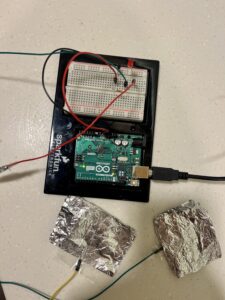I’m really into a band called Arcade Fire. They have a lyric that goes: “My body is a cage that keeps me from dancing with the one I love, but my mind holds the key…” This is how I view Interactive Media. Humans have always felt stunted by the limitations of themselves and their realities. I hold the metaphor of the Garden of Eden very closely. Adam and Eve were forced out of their original home and they have been lost ever since, wandering back. I believe we all have the Garden of Eden in our hearts, and everything we do is an attempt at finding home, at freeing the Garden of Eden within us. Our bodies house souls that are profoundly larger than our bodies themselves. So we all struggle with the cognitive dissonance of having a body. We want our spirits to be free. Interactive Media artists do this by creating different experiences and worlds with the technology at their disposal.
That’s why I wholeheartedly agree with Tigoe’s assertion that Interactive Media artists should allow their audiences to interact with their installations freely, without being bounded by rules and guidelines. Or else you risk negating the entire point of the practice–to help people confront and explore their hidden internal realities. That’s why I also agree with the Tigoe’s comment: “I think physical computing should ideally foreground the person’s input.”
Take, for example, the “Fields of Grass” archetype Tigoe mentioned. I thought it was funny when Tigoe said, “Why would you want to make a field of grass that you run your hand over? Because the idea of responsive texture is magical, I guess.” And it is. I think again of the movie Avatar, where, when Jake Sully entered the new world, the first thing he did was touch the glowing trees and grass in awe. I also recalled The Gladiator, where Maximus let his hand flow through the silver grass of the Fields of Elysium. One of my favorite Rumi quotes goes, “There is a field between right and wrong. I’ll meet you there.” Fields are windy and otherworldly and beautiful. If I were to start on a project, out of everything Tigoe said, I would start with this one, because it’s through creating magical fields that I feel like I’m closer to the Garden of Eden. It boggles me that I could make something that allows me to actually stand in something close to what the Garden of Eden looks like in my head.
But that’s my world and my interpretation. It would all be ruined if the I instructed other people on how to walk through the grass, or what to think when they did. Because then I’m imposing my internal world on them rather than allowing them to explore their own.
I also really liked Tigoe’s comment: “The limitation of this is that the gesture of moving your hand over a sensor has little meaning by itself. The challenge here is to come up with a physical form and context for the sensors that afford a meaningful gesture.” With every form of art, there comes a necessary suspension of disbelief. So naturally, when we’re interacting with an installation that allows us to leave our reality behind, we want to interact with it the way we can in the real world. That way, we can truly forget about reality for the one that is in front of us, and really believe it. That’s an obstacle that continues to stump Interactive Media artists to this day.
But I really loved Tigoe’s “heart beats faster when your loved one’s cell phone is detected in a cell that’s closer to you” example as well. Once, a visiting author named Fransisco Goldman said the point of art is to leave you saying, “And isn’t life just like that.” And that’s what I thought reading about that particular example–”isn’t life just like that.” That’s good interactive art.

